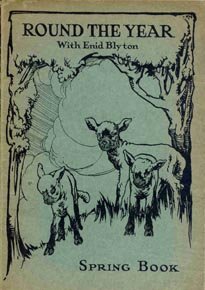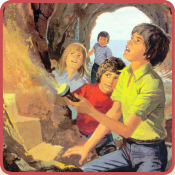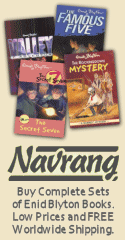
Round the Year with Enid Blyton - Spring Book

Book Details...
First edition: 1934
Publisher: Evans Brothers
Illustrator: Enid Blyton and Kathleen Nixon
Category: Round the Year with Enid Blyton
Genre: Nature
Type: Courses and Encyclopaedias
Publisher: Evans Brothers
Illustrator: Enid Blyton and Kathleen Nixon
Category: Round the Year with Enid Blyton
Genre: Nature
Type: Courses and Encyclopaedias
On This Page...
Reprints
Enid Blyton produced four books covering each season of the year, and later in the century they were published together in one volume. The photographs are rather old but it doesn't matter because flowers and insects don't really date, and the frontispiece picture of a man carrying two lambs in the earlier volume, isn't in the compilation edition. Humans date of course ... and that can be interpreted in whatever context one desires.'How to make a nature chart' is the opening chapter and personal experience with keeping a weather-record places it as 'interesting' for a child to pursue each day although interest can sometimes wane. The idea is to draw a month's supply of boxes and then fill them in daily with a picture depicting what the weather was like. Small illustrations of an umbrella, some rain or perhaps the sun can be drawn or pasted into the day's particular box and depending on 'whether the weather' alters during the day, whichever suits can be called into play. Pictures can also be cut from magazines and pasted in the squares of a separate Nature Chart to depict one's experiences in that line; the examples shown include a hedgehog, ash tree leaves, and a bird table.
The growing of seeds is covered and various ways to make them sprout are touched upon. Mustard and cress are oft-used examples when it comes to seed cultivation and one method is to place them on wet blotting paper surrounded by a glass cylinder, trusting of course that an average seven-year-old can lay hands on the appropriate equipment. Enid Blyton describes techniques in an interesting and easy-to-follow way so that even a 'how-to' chapter sounds almost like a story. At the end of each segment there's a 'Things to Do' list with practical exercises and various questions related to the supplied information.
A treatise on wind follows and the question arises as to how breezes form. The author explains this and includes other observations and interesting titbits. Pictures of yachts and a weather-cock are included and even an aerodrome wind-bag. The word 'aerodrome' for airport is more often used in Commonwealth countries according to those in the know.
Bulbs are discussed and there's a photograph of snowdrops flowering in a February fall, which is a well-remembered picture from bygone days. A diagram portrays bulbs cut in half and Enid Blyton explains their various aspects as if she's actually in the classroom addressing her pupils.
The next chapter is one that was read over and over prior to following the advice. Much reference was made to this article during the aquarium construction process whilst attempting to create an environment exactly like the one shown on Page forty-three. The gravel had to be well washed and another rule was faithfully adhered to - don't overcrowd the aquarium. Water snails were purchasable at the pet shop and cleaning the tank by means of a siphon was our introduction to a process based on physics. Here are some of the Things To Do: Watch for air-bubbles coming out of the waterweed. We did, and soon learnt how the liquid absorbs oxygen. Keep your aquarium clean. Draw the fish tank with fish and everything in it. Visit a pond to observe all the creatures within - beetles, fish, snails, frogs and other organisms.
There's a connected piece that contributes hints on stocking and the general upkeep of aquariums, which includes the addition of caddis grubs. The author has talked about these weird bits of life in several of her nature books and also commented on various other critters to be found in streams or ponds. Sticklebacks, minnows, water spiders, dragon-fly grubs and even beetles can be added to the aquarium although, as one or two of the aforesaid can be threatening to small fish, there's a list of creatures and their compatibility with each other.
Two birds - the blackbird and thrush are discussed next. How they twitter and what they eat is dealt with and there just has to be something about thrushes using a stone for an anvil when trying to break open a snail's shell. A photograph of the procedure is also included.
Chapters eight and nine deal with cultivating one's own garden and there are pictures of poppies and candytuft and cornflowers. We're shown how to make furrows and warned about shaking seeds out of a packet - "Only a boy or girl with a steady hand should do this." 'Annuals' and 'Biennials' are mentioned and hints are supplied on growing vegetables such as beans, cabbages, mustard and cress (of course), radishes, mint, and the rest.
Finally, there's a section entitled 'The Strange Cuckoo' and it demonstrates how weird this feathered creature really is. The female actually lays four or five eggs on alternate days and then deposits them in other birds' nests - very cleverly producing articles with much the same colouring as the host bird's clutch. But there's an exception - when selecting a hedge-sparrow's nest she lays a grey-brown spotted egg instead of one that matches the resident eggs which are generally of the 'purest brightest blue.' The reason for this is that hedge-sparrows are one of the few breeds that don't seem to notice whether their eggs match or not.
Now, how did they find that out?
2.
No doubt a glass cylinder could be substituted with something made of plastic or perhaps cardboard.
9.
'Annuals' and 'Biennials' are plants that flower either annually or every two years.
10.
An interesting photograph graces the 'Strange Cuckoo' chapter - it shows a two-day old cuckoo trying to eject a meadow-pipit's egg from the adopted nest.
The compilation volume that came out in 1950 contains a few alterations and/or additions. For example, in the original 'Nature Chart' chapter there's a photograph of two pilots and a third individual looking at a large weather chart whereas in the later book there's a similar shot but with four people viewing a map. The same thing occurs in the chapter entitled: 'Two Singers - Blackbird and Thrush.' A thrush is shown with her nestlings and although the pictures are very similar in both publications, the nests are in different surroundings and at different angles. Eric Hosking whom many will recall as a photographer of the period, takes credit for the later edition's photograph.
A question: How on earth did Enid Blyton gain all the intimate knowledge used in the mass of books she either wrote or to which she contributed? Some of the data would have come from her father of course, but as for the rest, well ... maybe she read tons of publications and stored the information acquired in a photographic memory.
Whether the weather be cold
Or whether the weather be hot,
We'll weather the weather,
Whatever the weather,
Whether we like it or not!







 Book 1 of 5 in this category
Book 1 of 5 in this category 